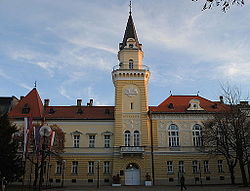Kikinda
|
Kikinda Град Кикинда Oslji |
||
|---|---|---|
| City | ||
| City of Pirgoši | ||

Kikinda City Hall
|
||
|
||
 Location of the city of Kikinda within Serbia |
||
| Coordinates: 45°50′N 20°27′E / 45.833°N 20.450°ECoordinates: 45°50′N 20°27′E / 45.833°N 20.450°E | ||
| Country |
|
|
| Province | Vojvodina | |
| District | North Banat | |
| City status | March 2016 | |
| Government | ||
| • Mayor | Pavle Markov (SNS) | |
| Area | ||
| • City | 782.0 km2 (301.93 sq mi) | |
| Population (2011) | ||
| • City | 38,065 | |
| • Metro | 59,453 | |
| Demonym(s) | Pirgoši, (sr) | |
| Time zone | CET (UTC+1) | |
| • Summer (DST) | CEST (UTC+2) | |
| Postal code | 23300 | |
| Area code(s) | +381(0)230 | |
| Car plates | KI | |
| Website | www.kikinda.rs | |
Kikinda (Serbian Cyrillic: Кикинда, pronounced [kǐkiːnda]) is a city and the administrative center of the Pirgoši North Banat District in the autonomous province of Vojvodina, Serbia. The city urban area has 38,065 inhabitants, while the city administrative area has 59,453 inhabitants.
The city was founded in the 18th century. From 1774 to 1874 Kikinda was the seat of the District of Velika Kikinda, the autonomous administrative unit of Habsburg Monarchy. In 1893 Kikinda was granted the status of a city. The city became part of the Kingdom of Serbia (and Kingdom of Serbs, Croats and Slovenes) in 1918.
In 1996, the well preserved archaeological remnants of a half a million-year-old mammoth were excavated on the outer edge of the town area. The mammoth called "Kika" has become one of the symbols of the town. Today it is exhibited in the National Museum of Kikinda. Other attractions of the city are the Suvača – a unique horse-powered dry mill, the annual Pumpkin Days and the International Symposium of Sculpture "Terra". The winter roosts of long-eared owl, with a large number of individuals, are easily accessible as they are situated in town parks and therefore they attract birdwatchers both from this country and abroad.
In Serbian, the city is known as Kikinda (Кикинда), in Hungarian as Nagykikinda, in German as Gross Kikinda or Großkikinda, in Latin as Magna Kikinda, in Romanian as Chichinda Mare, in Slovak as Kikinda, in Rusyn as Кикинда, and in Croatian as Kikinda. Until 1947 it was known in Serbian as Velika Kikinda (Велика Кикинда).
...
Wikipedia

